Sign up your students to see the large and the small Understand article
Science in School is published by EIROforum, a collaboration between eight of Europe’s largest inter-governmental scientific research organisations (EIROs). This article reviews some of the latest news from the EIROs.
CERN – Fourth Beamline for Schools competition announced

CERN is pleased to announce the fourth annual Beamline for Schools (BL4S) Competition. Once again, in 2017, a fully equipped beamline will be made available at CERN for students. As in previous years, two teams will be invited to the laboratory to execute the experiments they proposed in their applications. The 2017 competition is being made possible thanks to support from the Alcoa Foundation for the second consecutive year.
The competition is open to teams of high-school students aged 16 or older who, if they win, are invited (with two supervisors) to CERN to carry out their experiment. Teams must have at least five students but there is no upper limit to a team’s size (although only nine students per winning team will be invited to CERN). Teams may be composed of pupils from a single school or from a number of schools working together.
BL4S does more than just give high-school students a chance to play with real, functioning scientific equipment: it also exposes a host of students and teachers to particle physics and gives them the chance to be real scientists.
You can find out more about how to apply, about the beamline and facilities, and about previous winning teams on the BL4S website. The deadline for submissions is 31 March 2017.
To read about some of the previous winners in Science in School, visit: Jarlett H (2016) CERN’s high-school physics competition shines bright. Science in School 37: 19.
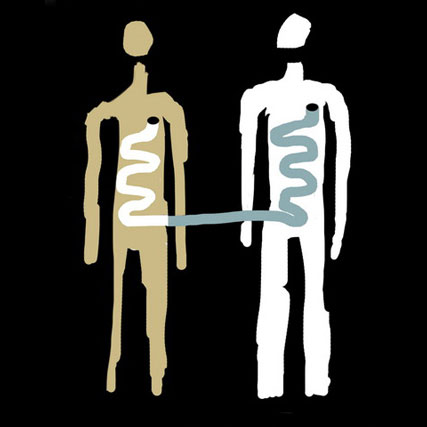
Levy / The Plain Dealer
Based in Geneva, Switzerland, CERN is the world’s largest particle physics laboratory.
EMBL – Whose poo is right for you?
For the first time, scientists studying stool transplants have been able to track which strains of bacteria from a donor take hold in a patient’s gut after a transplant. The team, led by EMBL with collaborators at Wageningen University and the Academic Medical Centre, both in the Netherlands, and the University of Helsinki, Finland, found that compatibility between donor and patient likely plays a bigger role in these transplants than previously thought. The study, published in Science, could help make stool transplants a valid option for more conditions than they are currently used to treat.
Learn more about the work on the EMBL website.
EMBL is Europe’s leading laboratory for basic research in molecular biology, with its headquarters in Heidelberg, Germany.
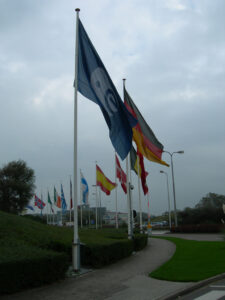
image source: Wikimedia
Commons
ESA – Citizens’ debate
On 10 September 2016, about 2000 citizens from 22 European countries will participate in the first Citizens’ Debate on Space for Europe. In the course of the day, participants will have the opportunity to learn, debate, have their say and suggest priorities on all aspects of current and future space programmes.
This consultation, on an unprecedented scale, will take place simultaneously in all 22 Member States of the European Space Agency (ESA). The Citizens’ Debate on Space for Europe is a major first – never before has the future of space activities been addressed in such an event held across so many countries.
ESA is Europe’s gateway to space, with its headquarters in Paris, France.
ESO – The visible and the hidden
During the Christmas holidays in 2016, from Friday 26 December to Thursday 1 January, 56 secondary school students aged 16–18 will spend a week in the Italian Alps doing astronomy activities and becoming part of a vibrant international community of alumni and astronomers.
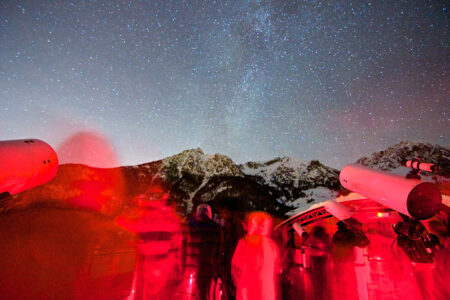
Durnwalder
Applications are now open for the ESO astronomy camp 2016. To apply, students should complete the form available from the website and upload a 3-minute video. The video should be in English on the theme “I would like to invent/discover… because”. Applications close on October 4, so hurry.
More information on the camp and how to apply is available here.
To read an account of a previous astronomy camp in Science in School, visit: Cenadelli D, Olivotto C, Sandu O, Christensen LL (2014) Camping under the stars — the ESO Astronomy Camp 2013. Science in School 30: 8.
ESO is the world’s most productive ground-based astronomical observatory, with its headquarters in Garching, near Munich in Germany, and its telescopes in Chile.
ESRF – New designs for a new generation
Following on from 20 years of success and scientific excellence, ESRF has embarked upon an ambitious modernisation project – the Upgrade Programme. After the successful delivery of the first phase, the ESRF – Extremely Brilliant Source (ESRF-EBS) project was launched to build a new and highly innovative 845 m long storage ring by 2020.
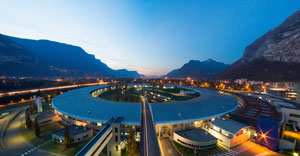
A blog has been created to tell the story of the construction and commissioning of the first of a new generation of synchrotrons. The blog shares the latest news and follows the evolution of the ESRF-EBS accelerator programme.
To read the blog and keep up to date with the progress of the project click here.
Situated in Grenoble, France, ESRF operates the most powerful synchrotron radiation source in Europe.
EUROFUSION – Journey to the centre of the torus
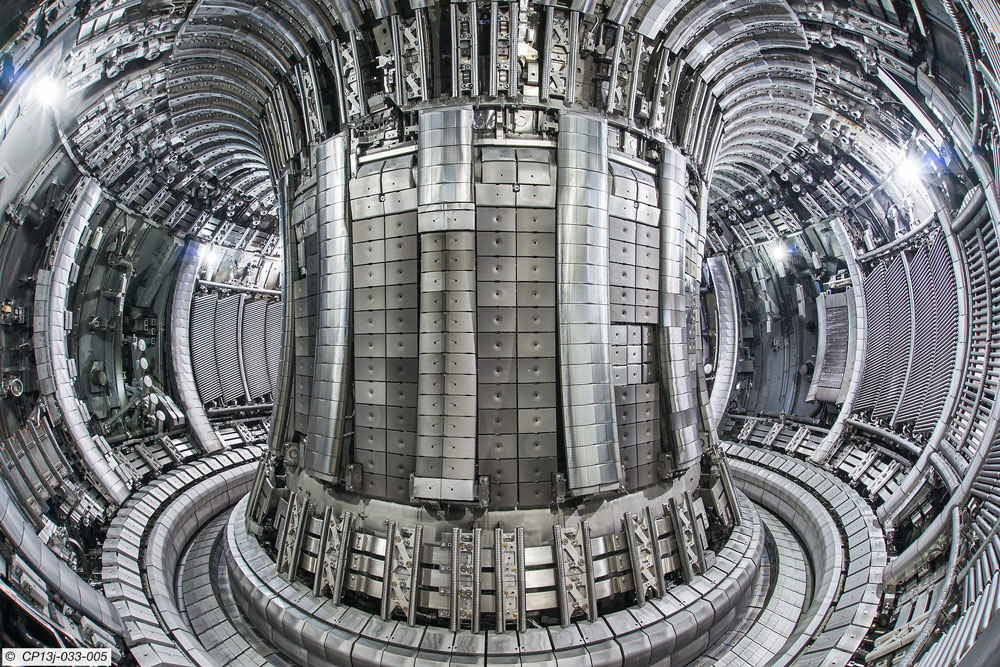
reaction vessel of JET
Image courtesy of EUROfusion
It sounds like a kind of gothic torture – being put in a large bucket and lowered into a 9 m deep hole at the centre of a huge machine. But it’s all in a day’s work for JET’s inspection team, as part of maintenance of JET’s central magnet, the P1 solenoid.
The solenoid itself is made up of 1440 turns of copper, separated into 14 sections stacked on top of each other. During the course of experiments, these coils carry up to 60 000 amps and are subjected to huge magnetic forces, which causes them to shift around slightly. A set of spring-loaded keys pulls the coils back into alignment, but over the course of thousands of plasma pulses you would expect these keys to wear and lose their precision.
“Actually no refurbishment was needed, even though this procedure was last done eight years ago,” says project leader Michael Porton. “In the intervening time, a number of key staff had retired, so we were partly re-learning how to do the work,” says Michael. “It’s not often you get to peer down the insides of JET!”
EUROfusion comprises 28 European member states as well as Switzerland and manages fusion research activities on behalf of Euratom. The aim is to realise fusion electricity by 2050.
European XFEL – First undulator installed, first superflat mirror delivered
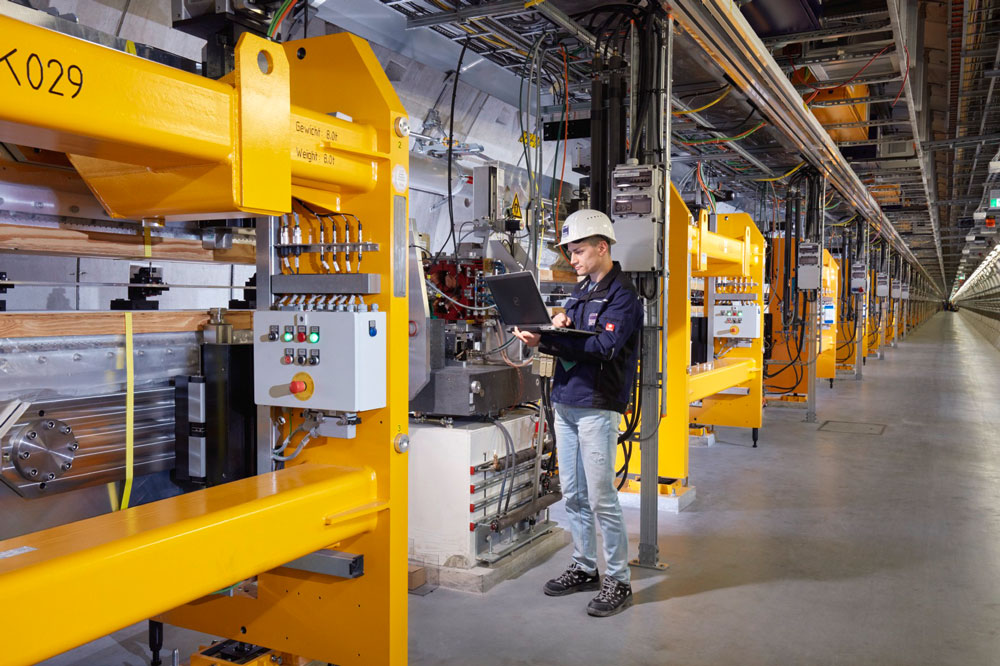
first fully installed undulator
system in the European
XFEL.
Image courtesy of Heiner
Müller-Elsner / European XFEL
Early in 2016, the installation of the 35 segments of the first of three X-ray light-producing components of the European XFEL was completed. Set into one of the facility’s tunnels, the segments are the core part of three systems called undulators, which are each up to 210 m long and will produce X-ray laser light more than a billion times greater than the intensity of conventional X-ray sources. The undulator installation is a major step towards the completion of the European XFEL.
Also of great importance was the delivery of the first specialised X-ray mirror. The mirror is superflat and does not deviate from its surface quality by more than one nanometre, or a billionth of a metre. It is the first of several needed for the European XFEL. The precision of the European XFEL mirror is equivalent to a 40 km long road not having any bumps larger than the width of a hair. As reported in the last issue of Science in School, the mirror’s production is the culmination of a long research and development process involving several institutes and companies in Japan, France, Italy and Germany.
Finally, European XFEL has moved to its new headquarters, situated on top of the facility’s underground experiment hall in the town of Schenefeld in Germany. User operation at the facility will begin in 2017.
The European X-ray Free Electron Laser (European XFEL) is a research facility currently under construction in the Hamburg area in Germany. Its extremely intense X-ray flashes will be used by researchers from all over the world.
ILL – New Director appointed

ILL
Image courtesy of S. Claisse
Professor Helmut Schober has been appointed, with effect from 1 October 2016, as the new Director of the Institut Laue-Langevin (ILL) in Grenoble, France, the world’s flagship centre for neutron science.
Professor Schober joined the ILL in 1994 and led the Institute’s Time-of Flight – High Resolution group from 2001 to 2011, before becoming Science Director and German Associate Director of the ILL.
Professor Schober was born and grew up in Bavaria, Germany. His research focused on fullerenes, the dynamics of liquids and glasses, and neutron instrumentation.
Professor Schober is also Associate Professor at the University Grenoble Alpes and was a visiting professor at the Technical University of Munich. He is a former chair of the German Committee for Research with Neutrons (KFN) and was the co-ordinator of the European Neutron and Muon Integrated Infrastructure Initiative (NMI-II).
ILL is an international research centre at the leading edge of neutron science and technology.






